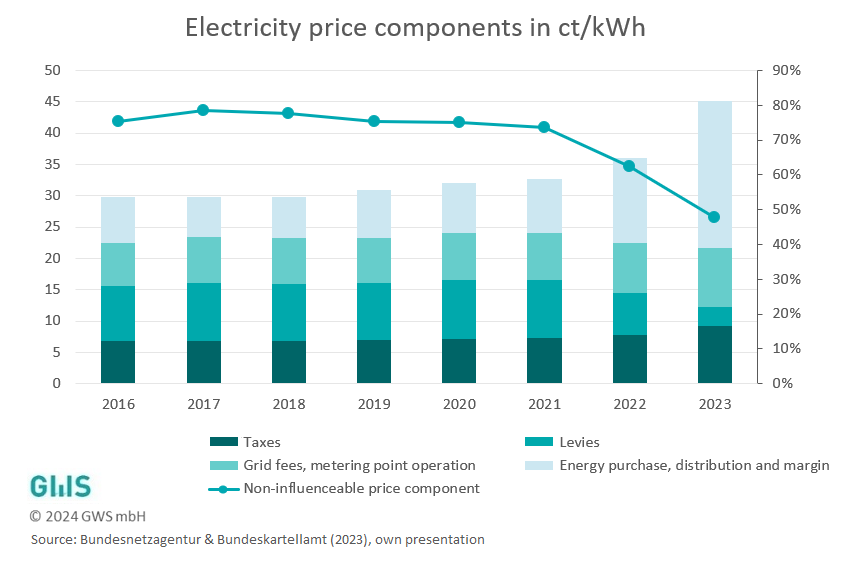Energy costs for households are still high – the savings potential is not being fully utilized
Our figure of the month 05/2024
Private households consume energy primarily in the form of natural gas for space heating and electricity for process heating and cooling (washing and cooking as well as cooling and freezing), lighting and information and communication technology.
Although energy consumption per living space is declining, the trend towards more households and fewer people per household leads to an increasing demand for space heating. Weather conditions also have a strong influence on this. More than two thirds of final energy consumption in private households is used for heating. Electricity demand is more stable over time and accounts for around one fifth (Arbeitsgemeinschaft Energiebilanzen, 2023).
Both gas and electricity prices for households have risen since 2016, especially since 2022. A look at the price components shows that "energy purchase, distribution and margin" in particular have increased. While taxes, levies, and grid fees as well as metering point operation and metering are price components that cannot be influenced by the provider, the energy purchasing costs, sales and margin can be influenced.


Due to the sharp rise in energy prices over the last two years, the German government has taken measures to ease the burden, on the one hand by capping energy prices as a whole and on the other hand by introducing state-regulated price components such as the abolition of the EEG levy on 1 July 2022, the federal subsidy for grid fees until the end of 2023 and the 7% VAT rate for gas until the end of March 2023.
The price components that cannot be influenced by suppliers have fallen from almost 80% to just under 50% for electricity and from around 56% to 27% for gas. In other words, customers can benefit from lower energy prices by switching suppliers, as the price for "energy purchase, sales and margin" vary depending on the supplier. The wholesale electricity price is currently back at around the 2021 level (approx. € 97 per MWh) and therefore more than half lower than in 2022. Wholesale gas prices have also fallen and are currently around € 26/MWh (EEX, Federal Network Agency 2024).
For gas, only 35% of household customers are with a competitive supplier and for electricity, 39% of household customers are not with the local basic supplier (Bundesnetzagentur, Bundeskartellamt 2023).
What consumers already practice when buying food and clothing in retail stores, for example, is not yet common practice when buying energy, although various portals increase transparency through price comparisons and energy-saving tips.
Sources:
- Arbeitsgemeinschaft Energiebilanzen (2023): Auswertungstabellen zur Energiebilanz Deutschland. Daten für die Jahre von 1990 bis 2022. Stand: November 2023 (endgültige Ergebnisse bis 2021, vorläufige Daten für 2022)
- Bundesministerium für Wirtschaft und Klimaschutz (BMWK) (2024): Der Strompreis. https://www.bmwk.de/Redaktion/DE/Artikel/Energie/strompreise-bestandteile.html, abgerufen am 25.04.2024.
- Bundesnetzagentur & Bundeskartellamt (2023): Monitoringbericht 2023. Monitoringbericht gemäß § 63 Abs. 3 i. V. m. § 35 EnWG und § 48 Abs. 3 i. V. m. § 53 Abs. 3 GWB. Stand: 29. November 2023. https://data.bundesnetzagentur.de/Bundesnetzagentur/SharedDocs/Mediathek/Monitoringberichte/MonitoringberichtEnergie2023.pdf, abgerufen am 25.04.2024.
- European Energy Exchange AG (EEX) & Bundesnetzagentur (2024): Gaspreise Großhandel in EUR/MWh. https://www.bundesnetzagentur.de/870302, letzte Aktualisierung am 24.04.2024, abgerufen am 25.04.2024.
- Bundesnetzagentur (2024): Haushaltskundenpreise – Entwicklung und Zusammensetzung der Strom-Haushaltskundenpreise seit 2016. SMARD. https://www.smard.de/page/home/topic-article/211972/212170, abgerufen am 25.04.2024.
- Bundesnetzagentur (2024): Haushaltskundenpreise – Entwicklung und Zusammensetzung der Gaspreise für Haushaltskunden seit 2016. SMARD. https://www.smard.de/page/home/topic-article/211972/212234, abgerufen am 25.04.2024.
Other figures can be found here.

